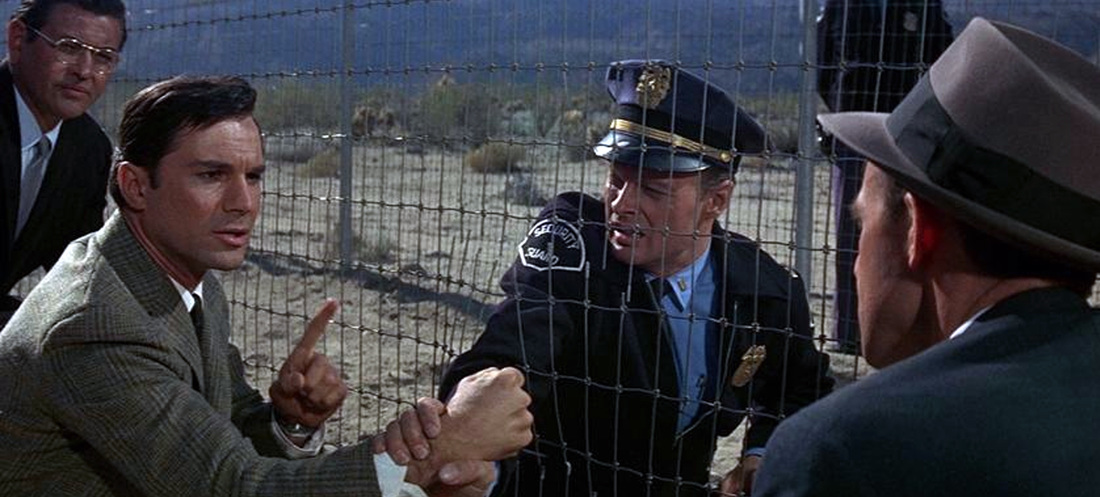I can’t begin to tell you the number of times The Satan Bug (1965) has appeared on my radar. Honestly, it seems like every week for the last year I stumbled across it in scouring IMDB.com’s biographies. A Blu-ray version even “streeted” of it a year back in 2015 (I think that may be the first time the United Artist release caught my interest), so you can imagine my delight when it finally dropped onto Turner Classic Movies’ schedule. I finally watched it the other night, and I wanted to sound off on it briefly.
Basically, Bug is a biological warfare thriller kinda/sorta in the same vein of The Andromeda Strain, which would be released by Universal Pictures six years later. The difference between the two of these closely-related films is that Andromeda’s man-killer comes from space while Satan’s “bug” (as it were) is entirely man-made. Here’s the (edited) plot summary as provided by Amazon.com:
“The Message is clear: put an end to war research... or prepare for the end of the Earth. Officials have no doubt about the madman s ability to carry out his threat; they know he has access to The Satan Bug. George Maharis, Dana Andrews and Anne Frances face the terror of a death germ in this race-against-time thriller directed by the great John Sturges. The Suspense begins at a top-secret U.S. germ warfare laboratory when containers of lethal microbe are stolen and soon after the group behind the theft proves its deadly resolve by using the weapon to completely annihilate the residents of a small town Florida community. The next target: Los Angeles... unless government agent Maharis and an elite task force can somehow prevent the City of Angels from becoming Hell on Earth.”
The capable Maharis is introduced late in the film’s set-up, and the script fashions him rather easily into what I suspect was intended to be a ‘thinking man’s James Bond.’ However, rather than show us just how good he is, the audience is informed of his exploits, and this necessarily removes some of the visual excitement that accompanies the standard Bond picture. Otherwise, everyone else in the film is rather flat and non-descript; even the normally plucky Anne Frances delivers her dialogue with somewhat surprising seriousness, even when flirting with Maharis. No one injects his or her character with much … well … character.
Perhaps Bug’s greatest sequence is when the cast is being treated to the videotaped aftermath of the first terrorist attack, that on the unsuspecting Floridians. A plane flies over a state highway lightly filled with stopped automobiles and dead people lying about the road; the virus killed them not quite instantly (as evidenced by the fact that they could get out of their vehicles), but the graveyard is captured in almost documentary fashion, leaving the cinema audience of its day to feel a sense of rising dread over what science has wrought. No words are required, and the sequence plays out long enough to make its point: this is serious stuff, and mankind ought to be alarmed.
Also, Bug fashions a pretty spiffy underground laboratory where scientists work to understand the science of biological warfare. Granted, it isn’t as high-tech looking as what eventually makes the aforementioned Andromeda Strain so memorable, but the production staffers should be commended for a job well done.
Lastly, Bug certainly deals with an interesting subject matter – the probable end of life as we know it by our own construction – and so far as stories go this one has an obvious beginning, middle, and end with plenty of modest “developments” sprinkled along the way. I think my issues with the film is that despite the premise of a world-destroying-virus-on-the-brink-of-being-released there’s just so little suspense delivered in the leaden performances of all involved (far too much seriousness and everyone seems like a cinema character instead of folks wrapped up in jeopardy). It’s good, but it’s no “owner” as today’s consumers might attest.
Think of this Bug as likely good for a single viewing but with practically zero re-watch quality.



 RSS Feed
RSS Feed